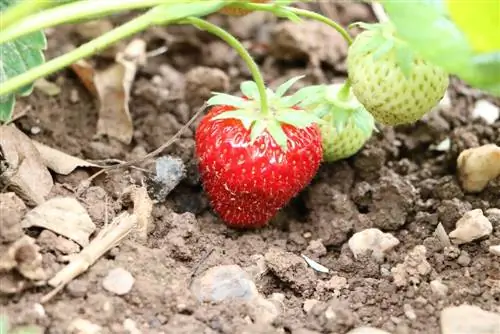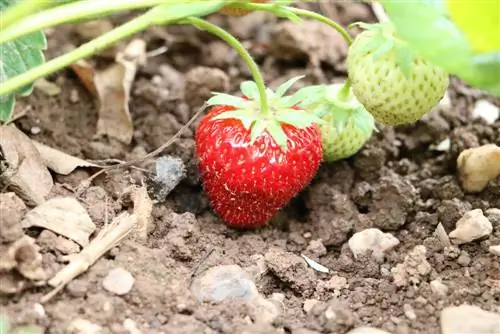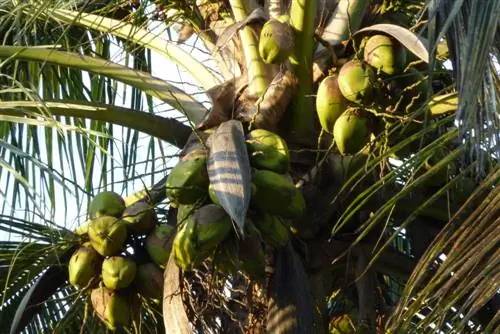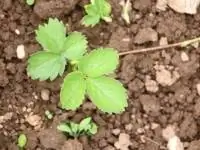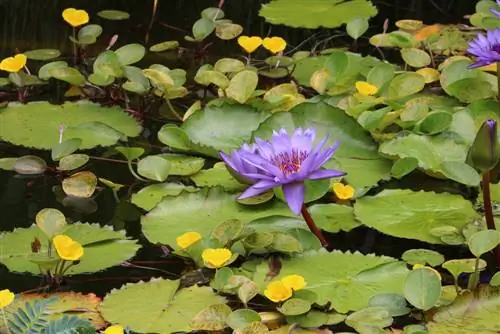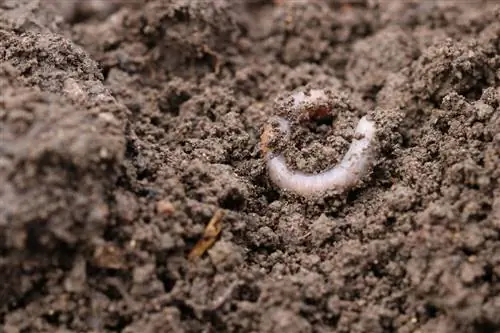- Author admin [email protected].
- Public 2023-12-17 03:39.
- Last modified 2025-06-01 06:48.
The best substrate for strawberries is not to be found under any special soil, but should contain a lot of soil, including humus and sand or similar, so that it is permeable and nice and loose. Buying soil used to be an easy exercise: drive by the local nursery, shovel a mortar full of potting soil and load in strawberry plants, fill the balcony box at home and plant strawberries. Today the choice of substrates is much larger, but there is no more soil.
The best substrate in the balcony box
The fact that the selection of substrates available for purchase is much larger today than before does not make purchasing the best substrate for strawberries any easier. On the contrary, you need to sort out more “substrates that are not good for strawberries”:
1. Ready packaged substrate
Today the nursery nearby no longer exists; The garden center and co. offer an unmissable variety of flower etc. soil from a few cents to a few euros per liter:
- There are many substrates suitable for balcony and other plants in the house and garden
- Active soil, potting soil, gardener's soil, gardener's planting soil and 18 others, up to universal soil
- 18 of 22 substrates have the word “earth” in their name
- None of them contain quantities that justify the product name “Earth”
- Earth is a mixture of approx. 50% minerals, up to 20% humus, air + water
- Air and water are difficult to sell in substrate, you have enough of them in the garden (but see below)
- Minerals mean clay, clay, sand and silt
- They are not scarce in the garden either (there are even more of them towards the center of the earth)
- What's missing in the garden is humus
- It is fundamentally important for a soil in which plants are supposed to grow
- Because it contains nutrients except for trace elements or stores them after fertilization
- And because it ensures that air and water are evenly distributed and integrated into the earth
- Forest soil contains approx. 20% humus, meadow 5-10%, field around 2%
- A humus content of between 10 and 30% is recommended for garden soil
Accordingly, one could assume that the commercially available substrates consist (to a large extent) of humus - but industrial substrate production did not develop to sell humus (but peat, which will be discussed below).
That's why Stiftung Warentest only found (small proportions of) humus or compost (humus + more concentrated nutrients) in less than half of the “potting soils” examined. In the product description you will not find any information about the humus content; according to the Fertilizer Ordinance, this does not have to be stated to end consumers.
The sale of air and water in the potting soil is also being tried: So that a substrate can no longer be made heavier and more expensive by water, our government mandated the measurement by volume a few years ago.
With the result that “a piece of air in bags” is now often sold with the substrate. The legislature has stipulated that the filling quantity must be checked during bottling in the factory. The substrate is carefully filled in very loosely until the bag is full to the brim. The bag is then transported and thrown back and forth and stored on top of each other until it is sold - which is why 50 out of 100 tested 20 liter bags of potting soil only fill the consumer's 20 liter balcony box by two thirds or less.
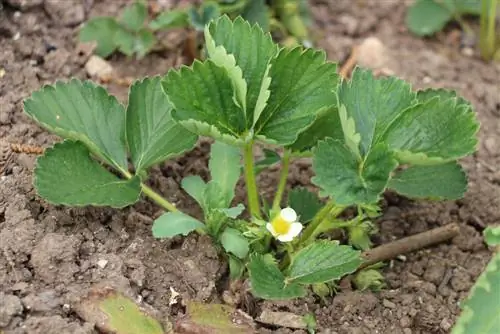
Tip:
If you buy substrate (or other products) whose seemingly huge capacity turns out to be a “pathetic pile”, you can send the package to your local weights and measures office. This ensures that you as a consumer get the weight you deserve. Since it is impossible to check all products on sale, the authorities rely on your help.
The quality of the whole thing was examined by Stiftung Warentest, here are the best quotes from the test report: “When buying potting soil, even the simplest calculation doesn't add up”, “Frustration experience”, “Stinginess of many suppliers”, “At Nitrogen deficiency: no growth", "stunted seedlings", "Almost one in eight samples turned out to be a "seed bag" (for weeds), "When potting soil dries out, it can become cracked like a parched desert soil", "A nuisance were the (incomplete, false) labels on many packages.
Stiftung Warentest has a few tips in store, such as “fertilize yourself if there is a lack of nutrients” or “put dried-out plants in the immersion bath”. Here is a tip that is very useful for plants: If possible, do not use these substrates on any plants. Easy to say, but a problem for city dwellers without a garden? Not true, in this case you will also find out how you can easily satisfy your strawberries.
2. Special soil for strawberries
Of course there is also soil or substrate specifically for strawberries, such as dozens of other special soils from azalea soil to houseplant soil.
The special substrates for strawberries are called: B. “PRO verde CD25” and “Ligno Mix C coarse berry fruit”. Here a declaration (intended for professionals) reveals what substrates are made of if they contain little to no soil or humus:
- 70 or 75% white peat
- 25 - 30% CocoDrain® (raw material from the coconut shell)
- Or LignoDrain® (raw material made from softwood without bark)
- Trace elements (how many?)
- Wetting agents (which ones?)
- 500 g NPK (does this mean fertilizer, which one?)
- Structure coarse-fibrous to coarse
- pH value 5, 7
The “invention of special products” is only worthwhile in terms of price because THE EARTH for azaleas (bamboos, camellias, strelicias) and houseplants does not exist. The type of plant is just one of many criteria - which is why it is not surprising that the (often poor) quality of the special substrates does not differ from the universal substrates (perhaps composed a little differently, but not always and if so, not necessarily to the benefit of the respective substrates). plants).
In the test, for example: B. toxic cadmium at the limit, insufficient nutrient content, weed seeds and an acidic environment that only allowed “modest growth” were found. Which then no longer even corresponds to the “quality criteria for growing media”, although under “plant compatibility” the only requirement is: “no growth inhibition or plant damage”.
The overall impression is that you will get a lot more out of it if you spend the time you spend looking for a specific substrate for strawberries learning about the soil requirements of strawberries.
3. The organic and eco-earth
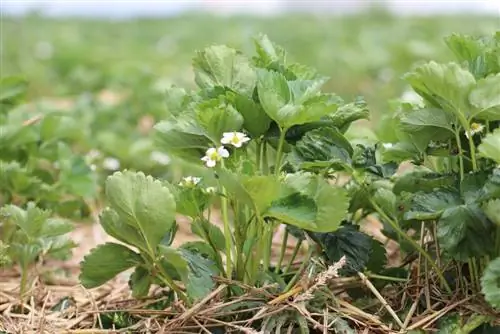
If home gardeners are informed that peat is created in moors in a process that lasts many generations and that moors play an important ecological role, e.g. B. bind the harmful greenhouse gas CO2 (which is why the extreme peat mining of the past decades has significantly worsened the earth's climate protection), they no longer like to see peat in their gardens.
If they know that the horticultural industry gets peat so cheaply that even the cheapest “peat in a bag” (disguised as potting soil) brings in record-breaking profit margins, they like seeing peat even less. When they realize that the horticultural industry does not pay for environmental damage (as of 2013: €1.4 billion annually), but that taxpayers are harming themselves with every peat purchase - the peat will finally remain at the garden door.
So the home gardener asks about the ingredients of the substrates:
- Cheap potting soil from the hardware store contains e.g. E.g. green waste compost, softwood bark, wood fiber and peat
- According to experience reports, it consists of 70% felty chopped waste
- In addition, wood residue and mold were found when opened
- The most expensive “potting soil with natural clay” consists of “high-quality standard soil”
- So by definition almost all peat and a little clay:
- Uniform earth is “a growing substrate for horticulture developed around 1950” which “consists of around 60 to 70% white peat or raised bog peat and 30 to 40% clay or subsoil loam”
- Even “organic” is not necessarily “eco”, at least not when it comes to growing media
- The “Bio-Active Substrate especially for strawberries” consists of 60% raised moor peat
- What only the user who gets to the “Technical Data Sheet” will find out
- As a last resort, the “Bio-Active Substrate is peat-free”
When it comes to growing media, “organic” is not necessarily “organic” because the term is not legally protected here. Which raw materials may be processed in substrates is stated in the annexes to the Fertilizer Ordinance. If you don't want parts of it in your flower pot/garden, the only solution is to look for substrates with an organic seal (and find out what the corresponding organic seal stipulates.
" Hobby gardeners don't need a green thumb, but a lucky hand when buying potting soil" was the (shortened here) conclusion of Stiftung Warentest from the big potting soil test. Unabridged further conclusion: “In the soils in which the test plants grew particularly well, the proportion of those containing compost was disproportionately high.”
Rephrased only slightly, this sentence leads to the most important finding of all when it comes to substrates, soil and plants: The soil in which the test plants grew splendidly contained a lot of compost (for a substrate); In other words: Plants grow splendidly when a substrate - in addition to all sorts of other hindering and harmful substances - also contains a little soil.
To put it even more briefly and precisely: Plants grow splendidly in soil! - Yes! And: Humus is the best peat substitute; Soil is the best substitute for soil.
4. The simple solution: organic, eco-friendly, inexpensive
More and more home gardeners are preparing the soil for their plants themselves. It's possible, it's actually very easy:
- Get plain, good soil with a humus content between 10 and 30% and mix this soil with:
- 20 - 30% pure, seasoned compost from green plants, provides nutrients
- 20 - 30% loosening components such as coarse sand, clay, pumice, perlite, fine gravel or bark humus
- A few trace elements and a little nitrogen, e.g. B. in the form of primary rock powder and horn shavings
If necessary, sift and mix everything well, resulting in a loose garden soil that consists of about half of normal soil and otherwise pretty well imitates the structure of the soil in which strawberries are at home in nature - the strawberries become are happy about “the piece of homeland” and grow accordingly contentedly.
Tip:
Whether in a plant pot or a bed: prepare the soil months or at least two weeks before planting the strawberries so that they can settle down. Before the strawberries are planted, this soil should no longer be worked to change its structure; strawberries do not like “freshly disturbed” soil at all.
The earth is the foundation
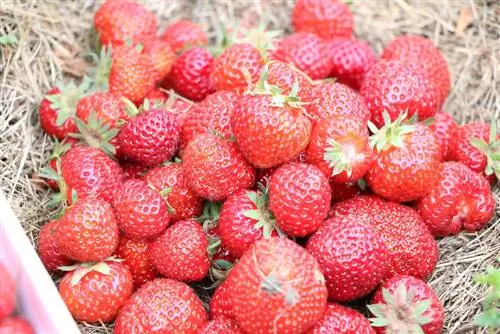
The basis for mixing your own substrate is soil, which you can obtain from the following sources:
1. Garden soil
Basically the best source for mixing substrate. How well your strawberries thrive in the substrate mixture depends on the condition of your garden soil.
If your garden is managed close to nature, the soil is cared for and in a good ecological balance, you have the perfect garden soil for mixing substrates at your disposal (and it can be assumed that you are aware of it).
If your garden has so far been cultivated “conventionally” (with synthetic fertilizers + pesticides), it is better to get soil from the sources mentioned under 2. Strawberries are not particularly fond of elements in the soil whose chemical composition corresponds to them is unknown.
2. Mother Earth
If you need to buy soil, you can buy where soil is sold in bulk: at a building materials dealer with an earth warehouse near you (who may also have diabase or bas alt mineral sand=primary rock powder, and sand etc. You can also get it there to loosen up).
You can find it at www.baustoffe-liefern.de, for Berlin there is e.g. B. at Tietz Baustoffe GmbH 1 m³=1.5 tons of topsoil/topsoil with 30% humus for €90. €90 for 1.5 tonnes is 9 cents for 1.5kg or €1.20 for the 20l bag; but here you can drive over again with the mortar (or have the soil delivered if that's worth it). You can also often buy soil from foresters, which would then be “real strawberry soil”.
Tip:
You can also buy the compost you need for mixing if your own compost heap isn't ready yet. Today, every municipality probably operates a public composting facility where you as a citizen can get good, controlled compost at low cost.

